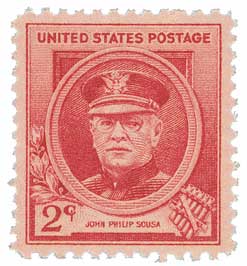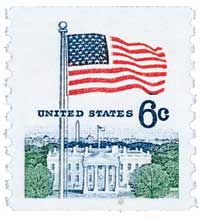
# 2276 FDC - 1987 22c Flag and Fireworks
 U.S. #2276
1987 22¢ Flag and Fireworks
City: Denver, CO
Quantity:Â 729,500,000
Printed By: Bureau of Engraving and Printing
Printing Method: Photogravure
Perforations: 11
Color: Multicolored
On May 14, 1897, John Philip Sousa’s band officially debuted his march “Stars and Stripes Forever†in Philadelphia, Pennsylvania. It quickly became a hit, with calls for it to replace the “Star Spangled Banner†as the national anthem. Instead, it was made the national march in 1987. Born in 1854, Sousa was a musician from an early age and was part of the Marine Band before becoming its leader in 1880. Under his leadership, the Marine Band became the country’s most respected military band. Sousa also composed several popular marches that got him dubbed “The March King.â€Â He then started his own civilian band in 1892 that toured the country and the world and brought him even more fame. Sousa was touring Europe in late 1896 when he received word that his music promoter had died. He and his wife boarded the first available ship to return home. Along the voyage, Sousa spent hours pacing the deck, looking up at the American flag. For about a month prior, he’d had a tune in his head – “On board the steamer as I walked miles up and down the deck, back and forth, a mental band was playing ‘Stars and Stripes Forever.’ Day after day as I walked it persisted in crashing into my very soul.†Sousa later explained that while he had been in Europe, he missed his days conducting the Marine Band and watching the flag fly overhead at the White House. Sousa thought of all the countries he visited and how they differed from America. “…and that flag of ours became glorified… and to my imagination it seemed to be the biggest, grandest flag in the world, and I could not get back under it quick enough.â€Â He said he couldn’t rest until he wrote it down, which he finally did on Christmas Day 1896. Then, “the feeling of impatience passed away, and I was content to rest peacefully until the ship had docked and I was once more under the folds of the grand old flag of our country.†Sousa set out on a national tour in 1897 and his band played “Stars and Stripes Forever†in a few small towns. It had its official debut, though, on May 14, 1897, in Philadelphia, Pennsylvania at the Philadelphia Academy of Music. The audience clamored over the song and asked for an encore – and they got two. A local newspaper claimed the song was “stirring enough to rouse the American eagle from his crag and set him to shriek exultantly while he hurls his arrows at the aurora borealis.†“Stars and Stripes Forever†quickly became a staple of his band’s repertoire. One Sousa historian said that they would have been “tarred and feathered and run out of town†if they didn’t play it. While he had other popular songs, “Stars and Stripes Forever†became his signature song. When asked what song he’d want to hear just before dying Sousa immediately responded, “Stars and Stripes Forever.â€Â On March 5, 1932, it was the last song his band played at a rehearsal, and he died the following morning. Four days later it was proposed that the song become the national march – which finally happened in 1987. Read Sousa’s original lyrics for the song here and watch a performance of it by the US Marine Band here.First Public Performance of “Stars and Stripes Foreverâ€





 U.S. #2276
1987 22¢ Flag and Fireworks
City: Denver, CO
Quantity:Â 729,500,000
Printed By: Bureau of Engraving and Printing
Printing Method: Photogravure
Perforations: 11
Color: Multicolored
On May 14, 1897, John Philip Sousa’s band officially debuted his march “Stars and Stripes Forever†in Philadelphia, Pennsylvania. It quickly became a hit, with calls for it to replace the “Star Spangled Banner†as the national anthem. Instead, it was made the national march in 1987. Born in 1854, Sousa was a musician from an early age and was part of the Marine Band before becoming its leader in 1880. Under his leadership, the Marine Band became the country’s most respected military band. Sousa also composed several popular marches that got him dubbed “The March King.â€Â He then started his own civilian band in 1892 that toured the country and the world and brought him even more fame. Sousa was touring Europe in late 1896 when he received word that his music promoter had died. He and his wife boarded the first available ship to return home. Along the voyage, Sousa spent hours pacing the deck, looking up at the American flag. For about a month prior, he’d had a tune in his head – “On board the steamer as I walked miles up and down the deck, back and forth, a mental band was playing ‘Stars and Stripes Forever.’ Day after day as I walked it persisted in crashing into my very soul.†Sousa later explained that while he had been in Europe, he missed his days conducting the Marine Band and watching the flag fly overhead at the White House. Sousa thought of all the countries he visited and how they differed from America. “…and that flag of ours became glorified… and to my imagination it seemed to be the biggest, grandest flag in the world, and I could not get back under it quick enough.â€Â He said he couldn’t rest until he wrote it down, which he finally did on Christmas Day 1896. Then, “the feeling of impatience passed away, and I was content to rest peacefully until the ship had docked and I was once more under the folds of the grand old flag of our country.†Sousa set out on a national tour in 1897 and his band played “Stars and Stripes Forever†in a few small towns. It had its official debut, though, on May 14, 1897, in Philadelphia, Pennsylvania at the Philadelphia Academy of Music. The audience clamored over the song and asked for an encore – and they got two. A local newspaper claimed the song was “stirring enough to rouse the American eagle from his crag and set him to shriek exultantly while he hurls his arrows at the aurora borealis.†“Stars and Stripes Forever†quickly became a staple of his band’s repertoire. One Sousa historian said that they would have been “tarred and feathered and run out of town†if they didn’t play it. While he had other popular songs, “Stars and Stripes Forever†became his signature song. When asked what song he’d want to hear just before dying Sousa immediately responded, “Stars and Stripes Forever.â€Â On March 5, 1932, it was the last song his band played at a rehearsal, and he died the following morning. Four days later it was proposed that the song become the national march – which finally happened in 1987. Read Sousa’s original lyrics for the song here and watch a performance of it by the US Marine Band here.First Public Performance of “Stars and Stripes Foreverâ€










